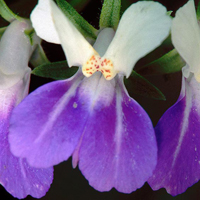Spring Blue-eyed Mary
Scientific name: Collinsia verna

Cover photo credit: Thomas G. Barnes, USDA-NRCS PLANTS Database
Status
Extirpated
“ Extirpated ” means the species lives somewhere in the world, and at one time lived in the wild in Ontario, but no longer lives in the wild in Ontario.
Date added to the Species at Risk in Ontario List
The Spring Blue-eyed Mary was already listed as extirpated when the Endangered Species Act took effect in 2008.
What it looks like
Spring Blue-eyed Mary belongs to the snapdragon family. It reaches 20 to 40 centimetres tall. The leaves are opposite, simple, mostly stalkless and lacking teeth or with only a few along the edges. The blossom typically consists of whorls of four to six flowers. Flowers have five lobes, the upper ones white to pale blue, the lower bright blue. This plant is a winter annual, so-called because seeds germinate in the fall and seedlings grow for a month or two, spend winter dormant, and resume growing in late winter and flower by late May.
Where it lives
Spring Blue-eyed Mary is usually found in open woodland within floodplains. It prefers moist rich soils and is often associated with Sugar Maple and White Oak trees.
Where it’s been found in Ontario
In Canada, this plant was reported from open woods in Middlesex, Oxford and Elgin counties in southwestern Ontario. Although it may still exist there, it has not been reported since 1954.
Spring Blue-eyed Mary is found throughout the eastern and midwestern United States, ranging from Pennsylvania west to Iowa, Missouri and Oklahoma, and south to Arkansas, northern Mississippi and western Virginia.
Why it disappeared from Ontario
The historical sites for Spring Blue-eyed Mary in Ontario were logged. This is believed to have resulted in the loss of this species from the province.
Action we are taking
Extirpated species and their habitat are protected if the species are again found in Ontario.
Help make sure we don’t lose more endangered species in Ontario
- the Ministry of Natural Resources and Forestry tracks species at risk such as the Illinois Tick-trefoil; you can use a handy online form to report your sightings to the Natural Heritage Information Centre; photographs with specific locations or mapping coordinates are always helpful
- report any illegal activity related to plants and wildlife to 1-877-TIPS-MNR (847-7667)
- private land owners have an important role to play in species recovery; you may be eligible for stewardship programs that support the protection and recovery of species at risk and their habitats
- the Carolinian forests of southern Ontario support an amazing diversity of plants and wildlife, including many species at risk; Carolinian Canada is working to help recover species at risk and their habitats; for more information, visit: www.carolinian.org/SpeciesHabitats.htm
- pollinators, such as bees, are in steep decline across the globe and they play a key role in the survival of many of Ontario’s rare plants; for information on how you can help scientists monitor pollinator populations in Ontario visit: www.seeds.ca/proj/poll
- volunteer with a local nature club or provincial park to participate in surveys or stewardship work focused on species at risk
Quick facts
- Spring Blue-eyed Mary looks very similar to the Violet Blue-eyed Mary (Collinsia violacea), a more southern species
- the plant’s flowers are pollinated by bees, butterflies and flies; the seeds lie dormant through the heat of summer and germinate once temperatures cool down in fall